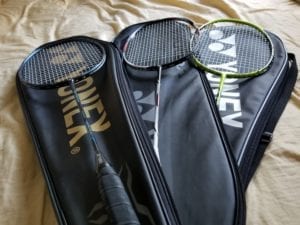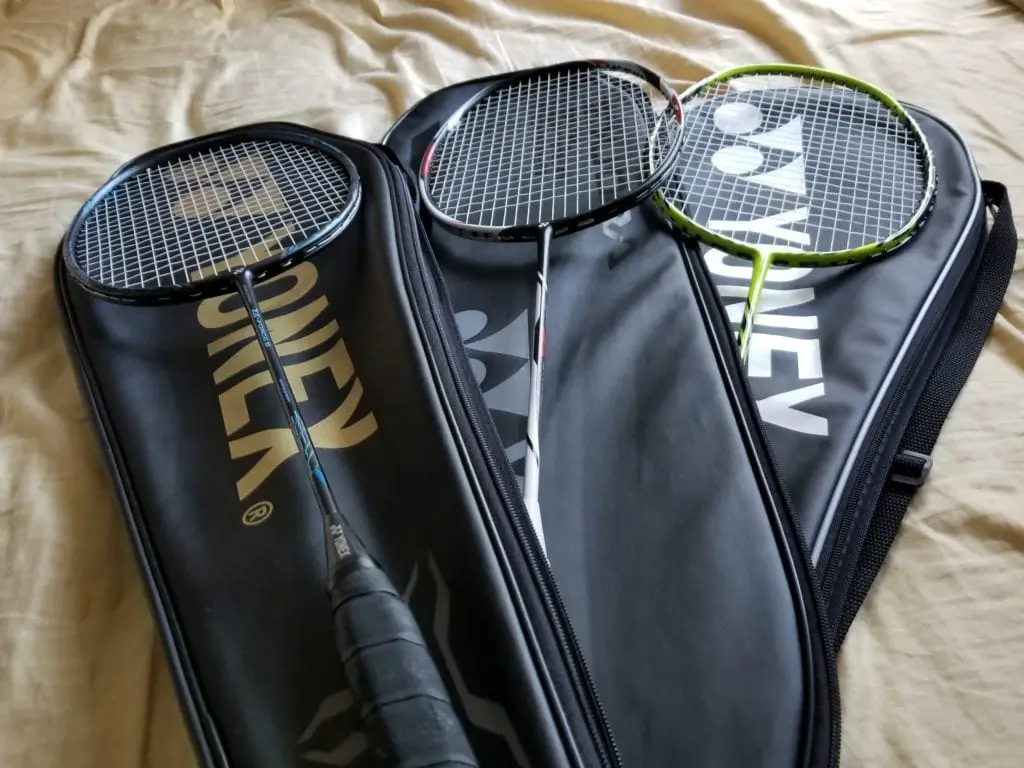The first statement I want to disprove is that your badminton racket does not affect how good you are. While you can’t blame your own racket for personal skill, sometimes the racket can really change your game. So now that you are here, it probably means you are out to choose your next racket.

When I was choosing my first few rackets, I realized I knew nothing about choosing rackets. My first racket, the Yonex Muscle Power 7 became quite unbearable to use after a year or so. My upgrade to the Yonex Voltric Z Force II made me into a completely new player. I struck luck on this one because I chose my racket with no information about what I liked but ended up with a good racket. But instead of striking luck like me, here’s how to choose a racket so you don’t accidentally blow off $200. First one is your play style which will determine what kind of balance, weight, shaft and head size you are going to go for.
But let’s jump into the technical details of a racket first.
Weight and Balance
When you’re choosing a racket, probably the first thing you think of is the weight. The weight is one of the most important aspects of a racket because if it’s too heavy, you will be fatigued or if it is too light, it doesn’t have enough power. Generally a lighter racket is good for fast reactions and a heavier racket is good for power shots like smashes and clears. Most rackets weigh between 80g and 90g. When you are buying a racket, the labels tell you a lot. The number associated with the U is the weight of the racket and as the number goes down the weight increases. E.g. 4U is lighter than 3U which is lighter than 2U. Most players choose between 4U and 3U for rackets. Another quick note is that rackets don’t necessarily have multiple U variants. The 20-28 lbs is the recommended stringing tension for the racket. Usually the stringing tension gets higher the lower the U.
While weight is important, another thing to consider is the balance of the racket. Rackets can be split into head heavy, even balance, and head light. Head heavy rackets are associated with power and a good head heavy racket will make it easier to hit shots like clears and smashes but at the cost of slower reactions. Head light rackets are the opposite of head heavy rackets as they’re much faster but hit weaker shots. And even balance is a mix between them. Most people actually don’t consider the head light rackets because you lose pretty much all the power and even balance rackets still have around the same reaction speed.
Shaft and Head of the Racket
The next few details about rackets are shafts and heads. When I’m talking about shafts, I am referring to their slimness and stiffness. Generally you want a slimmer shaft because it makes your shots much faster and makes it easier to move on a court but don’t worry about this too much since most badminton rackets are around the same slimness anyways.
The stiffness does matter though. A stiffer racket allows for more accurate shots but requires a little more strength for your swings and the flexible is just the opposite; less strength, less accuracy. Most people determine their stiffness from their skill level. Beginners usually go for a flexible racket because it does not punish mistakes as much and then more experienced badminton players go for stiffer rackets.
When we consider head types, once again it’s split into two, isometric and oval. Isometric is pretty much better in every aspect and oval is mainly just used for practice. This is because isometric has a bigger sweet spot (best place to hit the shuttle) and faster shots. Oval has a smaller sweet spot so you can practice hitting the shuttle in the right spot. But I definitely would choose isometric over oval.
Play Style
Now we’re onto play style which will inevitably determine the weight, balance, and shaft of your racket. There are a few questions you want to ask yourself. Do I play singles, doubles, or both? Am I good at smashing and clearing, am I good at defense? Ask yourself these types of questions to figure out how you play.
So once you have decided what kind of player you are, the next question to ask is, do I want a racket to cover my weaknesses or boost my strengths even more? I personally would choose a racket to cover my weaknesses because it allows me to improve my overall game. Badminton is the type of sport that you need to make sure you can play all kinds of different strategies.
It’s also a good idea that you try different rackets from friends and other people. This way you can find out what you truly like to play with. For example, you might think that you like head heavy rackets but then you find out you like even balance. So get out there and try rackets out!
Budget
This one is self-explanatory. Don’t buy a racket you can’t afford. But I will mention that more expensive rackets do feel better than less expensive ones. This is the same thing with newer rackets. The top rackets are usually above $200 but between $100 and $200 also has some really nice rackets.
Choose Your Next Badminton Racket!
There are also some more factors that you can consider but these are the basics of choosing a badminton racket. What I absolutely recommend you to do is to play some rallies with different rackets and see what you like. This is extremely important because not everyone is the same. For example, most singles players play with heavier rackets but you may like a light racket but you will only know this is you tested different rackets. The last quick note I want to put in is brands to choose from. Yonex, Li Ning, and Victor are the three major brands that I recommend; Yonex being my favorite and my personal racket of choice.
After reading this article, you’ve probably taken in a lot of info that is a little hard to keep up with so if you have any questions please them below. If you want a certain racket to be reviewed please also leave that in the comments. I’ll try my best to get reviews out and help you any possible way.
But for now, good luck and have fun in your badminton life!


Hi. Thank you for your very informative article. Batminton has always been a favourite sport of mine, and now that I’m getting older I need a comfortable, easy to handle racket, more then ever. IO will definitely be returning to your site for advice. Thanks Jim
That’s great to hear! I hope you choose out your dream racket. If you have any questions about badminton or anything really, don’t be afraid to ask!